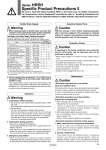
es40-57-hrshĀ@Ā@Ā@36 / 37
10ēbĆ„ā…BOOKāŐÉyĀ[ÉWā…ąŕďģāĶā‹ā∑
Facility Water Supply Warning 2. When using tap water as facility water, use water that conforms to the appropriate water quality standards. Use water that conforms to the standards shown below. Tap Water (as Facility Water) Quality Standards The Japan Refrigeration and Air Conditioning Industry Association JRA GL-02-1994 ĀgCooling water system . Circulation type . Make-up waterĀh Item Unit Standard value Influence Corrosion Scale generation Standard item pH (at 25ĀčC) . 6.5 to 8.2 v v Electric conductivity (25ĀčC) [É S/cm] 100* to 800* v v Chloride ion (Cl.) [mg/L] 200 or less v Sulfuric acid ion (SO4 2.) [mg/L] 200 or less v Acid consumption amount (at pH4.8) [mg/L] 100 or less v Total hardness [mg/L] 200 or less v Calcium hardness (CaCO3) [mg/L] 150 or less v Ionic state silica (SiO2) [mg/L] 50 or less v Reference item Iron (Fe) [mg/L] 1.0 or less v v Copper (Cu) [mg/L] 0.3 or less v Sulfide ion (S2 .) [mg/L] Should not be detected. v Ammonium ion (NH4 +) [mg/L] 1.0 or less v Residual chlorine (Cl) [mg/L] 0.3 or less v Free carbon (CO2) [mg/L] 4.0 or less v * In the case of [MÉ∂ĀEcm], it will be 0.001 to 0.01. . v: Factors that have an effect on corrosion or scale generation. . Even if the water quality standards are met, complete prevention of corrosion is not guaranteed. 3. Set the supply pressure between 0.3 to 0.5 MPa. Ensure a pressure difference at the facility water inlet/outlet of 0.3 MPa or more. If the supply pressure is high, it will cause water leakage. If the supply pressure and pressure difference at the facility water inlet/ outlet is low, it will cause an insufficient flow rate of the facility water, and poor temperature control. Operation Warning 1. Confirmation before operation 1) The fluid level of a tank should be within the specified range of ĀgHIGHĀh and ĀgLOWĀh. When exceeding the specified level, the circulating fluid will overflow. 2) Remove the air. Conduct a trial operation, looking at the fluid level. Since the fluid level will go down when the air is removed from the userĀfs piping system, supply water once again when the fluid level is reduced. When there is no reduction in the fluid level, the job of removing the air is completed. Pump can be operated independently. 2. Confirmation during operation ūŹ Check the circulating fluid temperature. The operating temperature range of the circulating fluid is between 5 and 35ĀčC. When the amount of heat generated from the userĀfs equipment is greater than the productĀfs capability, the circulating fluid temperature may exceed this range. Use caution regarding this matter. 3. Emergency stop method ūŹ When an abnormality is confirmed, stop the machine immediately. After the machine has stopped, make sure to turn off the breaker of the userĀfs equipment (on the upstream side). Operation Restart Time Caution Wait five minutes or more before restarting operation after it has been stopped. If the operation is restarted within five minutes, the protection circuit may activate and the operation may not start properly. Protection Circuit Caution If operating in the below conditions, the protection circuit will activate and an operation may not be performed or will stop. ūŹ Power supply voltage is not within the rated voltage range of Ā}10%. ūŹ In case the water level inside the tank is reduced abnormally. ūŹ Circulating fluid temperature is too high. ūŹ Compared to the cooling capacity, the heat generation amount of the userĀfs equipment is too high. ūŹ Ambient temperature is over 45ĀčC. ūŹ Ventilation hole is clogged with dust or dirt. Maintenance Caution